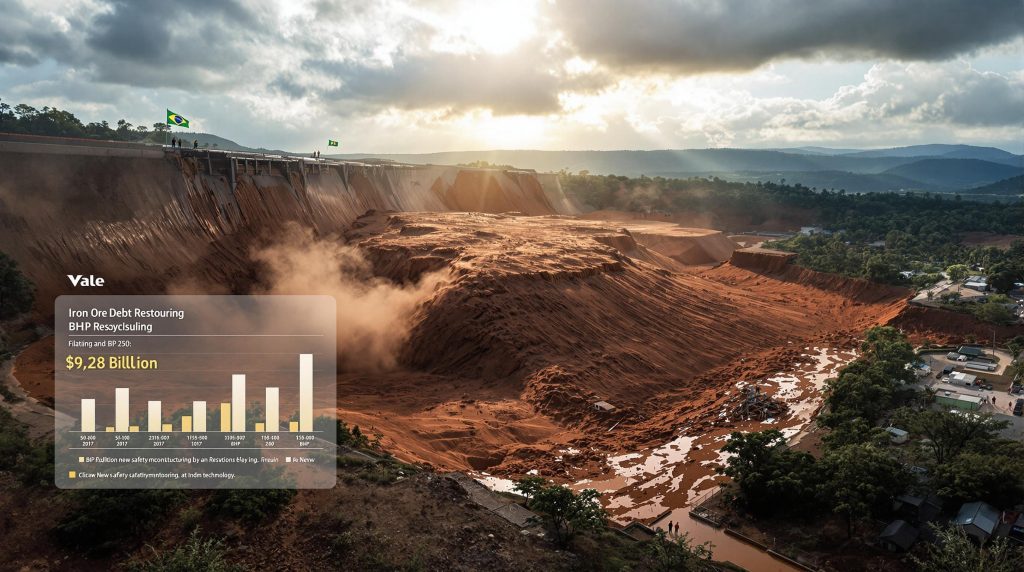Understanding Samarco's Bankruptcy Exit: What It Means for the Mining Industry
The mining industry witnessed a significant milestone as Samarco recently received court approval to exit bankruptcy proceedings after a lengthy restructuring process. This development marks a crucial turning point for the iron ore producer that has been working to recover from one of Brazil's worst environmental disasters. The approval from the Minas Gerais state court allows Samarco to reorganize its R$50 billion ($9.28 billion) debt and move forward with its operations, which could potentially impact iron ore price trends in the coming months.
What is Samarco and Why Was It in Bankruptcy?
The Joint Venture Background
Samarco Mineração S.A. operates as a 50-50 joint venture between two of the world's largest mining companies: Vale S.A. of Brazil and BHP Group of Australia. Before the 2015 disaster, Samarco was a significant player in Brazil's iron ore industry, specializing in producing iron ore pellets primarily for export markets.
The company operated a complex mining system that included open pit mines in Minas Gerais state, a 400-kilometer pipeline to transport iron ore slurry to processing facilities, and a pelletizing plant in Espírito Santo state. At its peak, Samarco contributed substantially to Brazil's position as a global iron ore exporter and provided thousands of jobs across its operational regions.
The Fundão Dam Disaster
The trajectory of Samarco changed dramatically on November 5, 2015, when its Fundão tailings dam collapsed near the city of Mariana in Minas Gerais state. The catastrophic failure released approximately 43.7 million cubic meters of mining waste and mud into the surrounding areas and waterways.
The disaster resulted in 19 fatalities and is considered one of Brazil's worst environmental catastrophes. The toxic mudflow destroyed the village of Bento Rodrigues and contaminated the Rio Doce river basin, affecting communities and ecosystems along a 650-kilometer stretch before reaching the Atlantic Ocean.
The environmental and social devastation forced Samarco to halt operations immediately. The company faced massive financial liabilities, including cleanup costs, compensation to affected communities, and regulatory penalties. These financial pressures, combined with the inability to generate revenue during the operational shutdown, eventually led Samarco to file for bankruptcy protection.
How Did Samarco Navigate the Bankruptcy Process?
The Scale of Financial Restructuring
The bankruptcy process for Samarco involved restructuring approximately R$50 billion ($9.28 billion) in debt with around 10,000 creditors. This enormous financial restructuring represents one of Brazil's largest corporate debt reorganizations in recent history.
The complexity of the case stemmed not only from the large debt amount but also from the diverse range of creditors involved—from major financial institutions to small businesses affected by the disaster, as well as environmental agencies and community representatives seeking compensation.
The Judicial Recovery Process in Brazil
Samarco filed for "recuperação judicial" (judicial recovery) under Brazilian bankruptcy law. This process is somewhat similar to Chapter 11 bankruptcy protection in the United States, designed to give financially troubled companies the opportunity to restructure their debts while continuing operations.
The judicial recovery process in Brazil involves several key stages:
- Initial filing and acceptance by the court
- Presentation of a recovery plan to creditors
- Creditor negotiations and potential modifications to the plan
- Creditor voting on the proposed restructuring plan
- Court approval of the agreed plan
- Implementation and monitoring of the recovery plan
Samarco's case was particularly complex due to the environmental liabilities involved and the high-profile nature of the disaster. The proceedings took place in the Minas Gerais state court, where the company's mining operations are located.
What Does the Court Approval Mean for Samarco's Future?
Operational Implications
The court approval to exit bankruptcy proceedings represents a crucial step toward stability for Samarco. After several years of operational shutdown following the 2015 disaster, the company partially resumed production in December 2020, albeit at significantly reduced capacity.
The restart involved the use of a new tailings filtering system and dry-stack storage method, designed to eliminate the need for conventional tailings dams like the one that failed in 2015. This technological shift reflects the company's commitment to preventing similar disasters in the future.
Current production remains well below pre-disaster levels, with the company focusing on gradual recovery while implementing enhanced safety measures. The exit from bankruptcy protection provides Samarco with greater financial flexibility to continue investing in operational improvements and safety technologies.
Financial Outlook
The restructuring plan approved by the court establishes a framework for Samarco to address its substantial debt burden while rebuilding its business. Financial experts suggest that the company will need to raise significant capital—potentially around $2 billion—to fund ongoing operations and environmental remediation efforts.
The new debt structure likely includes extended repayment timelines, possibly with reduced interest rates or partial debt forgiveness from some creditors. This restructured financial framework aims to make the company viable while ensuring it meets its obligations to creditors and affected communities.
Samarco's path to financial stability will depend heavily on iron ore market outlook conditions, its ability to increase production gradually, and the ongoing support of its parent companies, Vale and BHP. The company might need to explore various capital raising methods to secure its future operations.
How Does This Impact Vale and BHP?
Financial Obligations
As joint venture partners, Vale and BHP have maintained financial support for Samarco throughout the crisis. Both companies have contributed to funding the cleanup efforts and compensation programs, primarily through the Renova Foundation established specifically to manage disaster remediation.
The bankruptcy exit potentially clarifies the ongoing financial commitments required from both parent companies. While specific details of the restructuring agreement haven't been fully disclosed, industry analysts suggest that Vale and BHP will likely continue providing financial guarantees and operational support to ensure Samarco's recovery.
The resolution of Samarco's bankruptcy proceedings may also help Vale and BHP better quantify their long-term financial exposure related to the disaster, potentially reducing uncertainty for their own shareholders.
Corporate Reputation and ESG Considerations
Both Vale and BHP have faced significant reputational damage from the Samarco disaster. The incident highlighted serious concerns about their environmental management practices and oversight of joint venture operations.
In response, both companies have implemented enhanced governance structures and safety protocols across their global operations. They've also increased transparency regarding tailings dam management and invested in technological solutions to reduce similar risks.
The Samarco bankruptcy exit represents a step toward resolving one of the most challenging ESG (Environmental, Social, and Governance) issues facing both companies. However, rebuilding trust with affected communities, environmental advocates, and ESG-focused investors remains an ongoing challenge.
What Are the Broader Implications for Mining Industry Standards?
Regulatory Changes
The Fundão dam disaster prompted significant regulatory changes in Brazil and influenced global mining standards. Brazil implemented stricter regulations for tailings dam construction, monitoring, and emergency planning.
In February 2022, Brazil enacted a law prohibiting the upstream dam construction method—the type used at Fundão—and requiring mining companies to decommission existing upstream dams by 2027. The legislation also mandated more rigorous safety certifications and increased liability for mining executives.
Internationally, the disaster catalyzed the development of the Global Industry Standard on Tailings Management, launched in August 2020. This standard, developed through a collaboration between the United Nations Environment Programme, Principles for Responsible Investment, and the International Council on Mining and Metals, establishes global best practices for tailings facility management.
Industry-Wide Risk Management
The mining industry has witnessed a fundamental shift in how companies approach risk management since the Samarco disaster. Major mining companies have conducted comprehensive reviews of their tailings storage facilities globally and increased disclosure about potential risks.
Technological innovations in tailings monitoring have accelerated, including:
- Real-time monitoring systems using sensors and satellite technology
- Advanced predictive analytics to identify potential failure signals
- Improved design methodologies for tailings storage
- Alternative tailings disposal methods, such as filtered, dry-stack tailings
Investors now demand greater transparency regarding tailings management, with many institutional investors specifically evaluating mining companies' approaches to tailings safety as part of their ESG assessments.
What Compensation Has Been Provided to Affected Communities?
The Renova Foundation
In response to the disaster, Vale and BHP established the Renova Foundation in 2016 to implement remediation and compensation programs. The foundation was created as part of a settlement agreement with Brazilian authorities and has been tasked with executing numerous recovery initiatives.
The foundation's work encompasses:
- Environmental restoration of affected waterways and landscapes
- Rebuilding destroyed communities and infrastructure
- Providing financial compensation to affected individuals and businesses
- Supporting economic recovery in impacted regions
- Monitoring long-term environmental and health impacts
The foundation has faced criticism regarding the pace of compensation distribution and rebuilding efforts. Many affected families continue to await permanent housing and full compensation more than seven years after the disaster.
Ongoing Legal Challenges
Despite the bankruptcy exit, Samarco and its parent companies still face numerous legal challenges related to the disaster. Criminal proceedings against former executives continue in Brazilian courts, while civil claims from affected communities and environmental organizations remain active.
In 2019, Vale faced another major tailings dam disaster at its Brumadinho facility, which intensified scrutiny of the company's safety practices and complicated the legal landscape surrounding mining disasters in Brazil.
The legal proceedings related to the Fundão disaster could continue for many more years, representing an ongoing uncertainty for Samarco and its parent companies even as the bankruptcy restructuring concludes.
What Lessons Can the Mining Industry Learn?
Technical and Engineering Insights
The Fundão dam failure has been extensively studied by engineering experts, revealing critical lessons about tailings dam design and management. Technical investigations identified several contributing factors to the collapse:
- Structural design flaws in the original dam construction
- Inadequate drainage systems that led to increased saturation
- Changes to the dam's original design during operational phases
- Insufficient monitoring of potential warning signs
- Inadequate emergency response planning
These findings have informed improved engineering practices across the industry, including more conservative design parameters, enhanced monitoring systems, and stricter change management processes for tailings facilities.
Corporate Governance Improvements
The disaster highlighted significant governance failures in oversight of high-risk infrastructure. In response, mining companies globally have implemented governance reforms, including:
- Board-level oversight of tailings management and critical safety risks
- Independent technical review panels for high-consequence facilities
- Enhanced reporting requirements and transparency about safety incidents
- Improved whistleblower protections for safety concerns
- Alignment of executive compensation with safety performance metrics
These governance improvements aim to ensure that potential safety risks receive appropriate attention at the highest levels of corporate decision-making.
How Might Samarco's Recovery Affect Brazil's Mining Sector?
Economic Impact
Prior to the disaster, Samarco was a significant contributor to Brazil's mining sector and local economies in Minas Gerais and Espírito Santo states. The partial resumption of operations has begun to restore some economic benefits, including:
- Direct employment opportunities at mining and processing facilities
- Indirect jobs through the supply chain and service providers
- Tax revenue for local and state governments
- Foreign exchange earnings through iron ore exports
Full recovery will take many years, but the bankruptcy exit provides a more stable foundation for rebuilding economic contributions. The pace of recovery will depend on Samarco's ability to gradually increase production while maintaining enhanced safety standards.
Regulatory Environment
Brazil's mining regulatory framework has undergone substantial changes since the Fundão disaster. The National Mining Agency (ANM), established in 2017 to replace the previous regulatory body, has implemented more stringent oversight of mining operations, particularly regarding tailings management.
Key regulatory changes include:
- More frequent inspections of high-risk mining infrastructure
- Enhanced reporting requirements for safety incidents
- Stricter technical standards for dam construction and monitoring
- Increased financial assurance requirements for potential remediation
- Mandatory emergency action plans for communities downstream of tailings facilities
Samarco's experience navigating this enhanced regulatory environment will likely influence how other Brazilian mining companies approach compliance and risk management, including those currently facing challenges like the Onslow iron project halt.
FAQ: Samarco's Bankruptcy Exit
What were the key terms of Samarco's debt restructuring?
The court-approved restructuring plan addresses approximately R$50 billion ($9.28 billion) in debt across around 10,000 creditors. While complete details haven't been publicly disclosed, the plan likely includes extended repayment periods, potential interest rate adjustments, and possibly some debt forgiveness components.
The restructuring aims to create a sustainable financial framework that allows Samarco to continue operations while meeting its obligations to creditors, affected communities, and environmental remediation requirements.
How has Samarco's operational model changed since the disaster?
Samarco has fundamentally transformed its operational approach since resuming limited production in December 2020. Key changes include:
- Implementation of a tailings filtering system that reduces water content in waste material
- Adoption of dry-stack tailings storage rather than conventional dams
- Enhanced monitoring technology throughout the mining and processing chain
- Reduced production capacity with phased expansion plans
- Strengthened safety management systems and emergency response capabilities
These operational changes reflect the company's commitment to preventing similar disasters while rebuilding a sustainable business model.
What ongoing obligations do Vale and BHP have regarding Samarco?
As 50-50 joint venture partners, Vale and BHP maintain significant responsibilities related to Samarco's operations and the disaster remediation. Their ongoing obligations include:
- Financial support for Samarco's operational recovery
- Funding commitments to the Renova Foundation for remediation work
- Governance oversight of Samarco's management and safety practices
- Potential financial guarantees as part of the restructuring agreement
- Continued engagement with regulatory authorities and affected communities
The bankruptcy exit helps clarify these obligations but doesn't eliminate the parent companies' long-term responsibilities related to the disaster.
How does Samarco's case compare to other mining bankruptcy proceedings?
Samarco's bankruptcy case stands out due to several unique factors:
- The direct link to a catastrophic environmental disaster
- The involvement of two global mining giants as joint venture partners
- The complex mix of financial, environmental, and social liabilities
- The high international profile and ongoing regulatory scrutiny
- The parallel criminal and civil proceedings related to the disaster
These factors made Samarco's restructuring particularly complex compared to typical mining bankruptcies, which often result from market downturns or operational challenges rather than disaster-related liabilities.
The Future of Mining Safety After Samarco
The Samarco case has become a watershed moment for the global mining industry, fundamentally changing how companies approach tailings management and environmental risk. The bankruptcy exit represents not just a financial restructuring but an opportunity to demonstrate how mining companies can recover from disasters by prioritizing safety, environmental responsibility, and community engagement.
For investors, regulators, and communities worldwide, Samarco's ongoing recovery will serve as a critical case study in disaster response, corporate accountability, and the mining industry's ability to reform its practices in response to catastrophic failures.
As Samarco works to rebuild its operations and restore trust, the legacy of the Fundão disaster continues to influence mining standards and practices globally—a reminder of the high stakes involved in managing environmental and safety risks in resource extraction. The industry now places greater emphasis on mine reclamation importance as a critical component of responsible mining operations, especially in the wake of disasters like Samarco's.
Ready to Capitalise on the Next Major Mining Opportunity?
Discovery Alert's proprietary Discovery IQ model provides instant notifications when significant ASX mineral discoveries are announced, delivering actionable insights that could help you identify the next major mining opportunity before the broader market. Explore historic examples of exceptional returns from major discoveries on our dedicated discoveries page.




